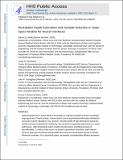Modulation Depth Estimation and Variable Selection in State-Space Models for Neural Interfaces
Author(s)
Malik, Wasim Q.; Hochberg, Leigh R.; Donoghue, John P.; Brown, Emery Neal
DownloadBrown_Modulation depth.pdf (1.527Mb)
OPEN_ACCESS_POLICY
Open Access Policy
Creative Commons Attribution-Noncommercial-Share Alike
Terms of use
Metadata
Show full item recordAbstract
Rapid developments in neural interface technology are making it possible to record increasingly large signal sets of neural activity. Various factors such as asymmetrical information distribution and across-channel redundancy may, however, limit the benefit of high-dimensional signal sets, and the increased computational complexity may not yield corresponding improvement in system performance. High-dimensional system models may also lead to overfitting and lack of generalizability. To address these issues, we present a generalized modulation depth measure using the state-space framework that quantifies the tuning of a neural signal channel to relevant behavioral covariates. For a dynamical system, we develop computationally efficient procedures for estimating modulation depth from multivariate data. We show that this measure can be used to rank neural signals and select an optimal channel subset for inclusion in the neural decoding algorithm. We present a scheme for choosing the optimal subset based on model order selection criteria. We apply this method to neuronal ensemble spike-rate decoding in neural interfaces, using our framework to relate motor cortical activity with intended movement kinematics. With offline analysis of intracortical motor imagery data obtained from individuals with tetraplegia using the BrainGate neural interface, we demonstrate that our variable selection scheme is useful for identifying and ranking the most information-rich neural signals. We demonstrate that our approach offers several orders of magnitude lower complexity but virtually identical decoding performance compared to greedy search and other selection schemes. Our statistical analysis shows that the modulation depth of human motor cortical single-unit signals is well characterized by the generalized Pareto distribution. Our variable selection scheme has wide applicability in problems involving multisensor signal modeling and estimation in biomedical engineering systems.
Date issued
2015-01Department
Massachusetts Institute of Technology. Institute for Medical Engineering & Science; Massachusetts Institute of Technology. Department of Brain and Cognitive Sciences; Picower Institute for Learning and MemoryJournal
IEEE Transactions on Biomedical Engineering
Publisher
Institute of Electrical and Electronics Engineers (IEEE)
Citation
Malik, Wasim Q., Leigh R. Hochberg, John P. Donoghue, and Emery N. Brown. “Modulation Depth Estimation and Variable Selection in State-Space Models for Neural Interfaces.” IEEE Trans. Biomed. Eng. 62, no. 2 (February 2015): 570–581.
Version: Author's final manuscript
ISSN
0018-9294
1558-2531